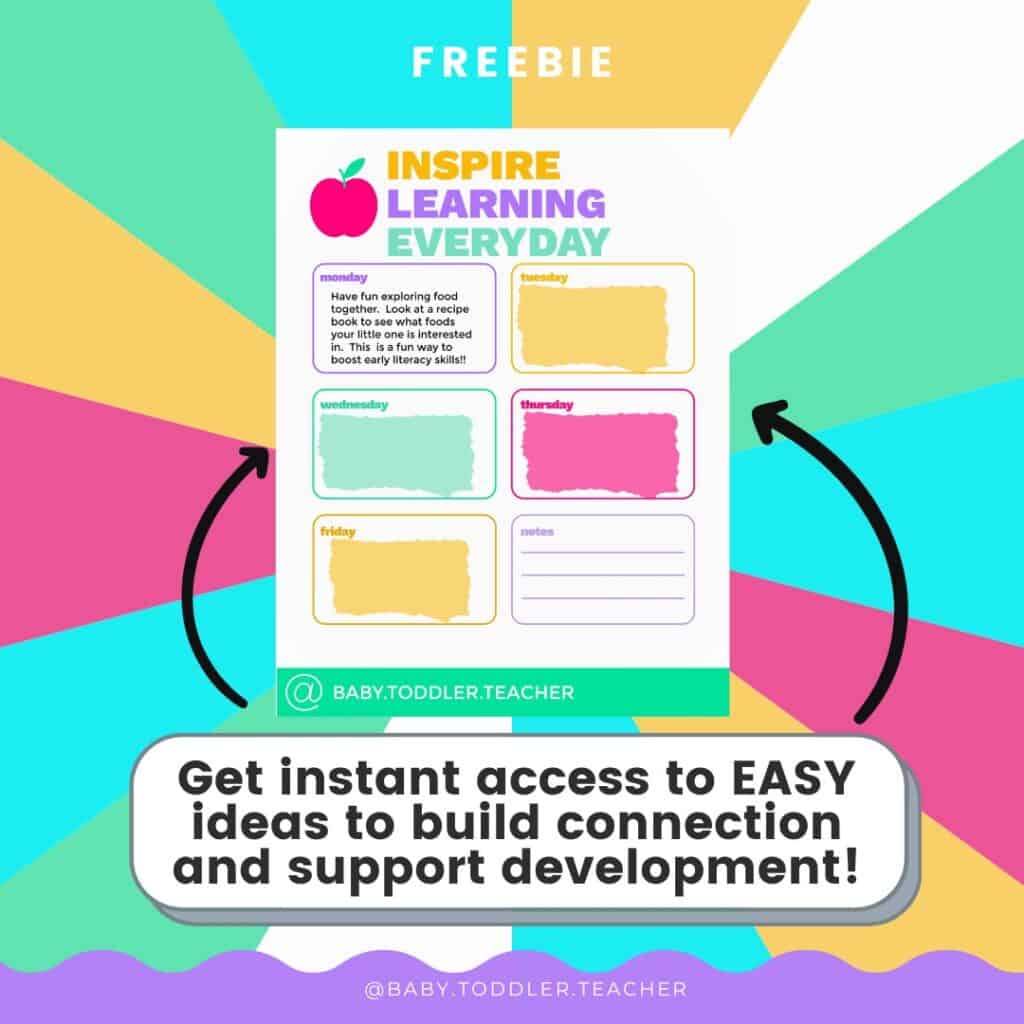Are you wondering what to expect when it comes to your baby standing?
It is a major milestone that parents get very excited about as their little one transitions from babyhood to toddlerhood!
I have been working in early childhood for over 10 years and I can tell you these developmental milestones will come at different times for every child.
It is important to remember that all babies are unique and will meet this milestone at their own pace.
Just because someone else’s baby is doing something does not mean your baby is behind or not meeting their milestones.
Listen to your gut…if you ever do have concerns about your baby’s development make sure to get those addressed by your pediatrician or early intervention.
When I look at my two children they have developed very differently!
My daughter started rolling before my son did.
My son started crawling earlier than my daughter.
They were both on different timelines, and their rate of development still fell within the range of “age appropriate” for their milestones.
If your baby pulls to stand at 6 months that is “age appropriate” If your baby pulls to stand at 10 months…that is considered “age appropriate” as well!
Here are some of the things we will cover in this post:
- What age do babies stand?
- What skills come before standing?
- What toys will help my baby build the strength to stand?
- What can I do to help my baby stand?
- Standing Milestones You Can Expect
- Should I be concerned if my baby isn’t standing?
- What red flags should I watch out for?
- My Baby is standing! What milestones should I expect next?
- My baby stopped talking while learning to stand and walk…should I be concerned?
- What shoes work best for babies to learn to stand and walk in?
- Will Standing too early cause my baby to be bowlegged?
- Safety Concerns When Your Baby is Learning to Stand
- Baby Proof Your House for New Milestones

(This post contains affiliate links. To read our full disclosure policy click here.)
Baby Standing Milestones: Everything You Need to Know
Babies typically start pulling to stand sometime between 6-10 months. This will vary from one infant to the next.
Some babies like to be in an upright standing position when playing while others do not.
It is good to allow your child to explore different positions. However putting your baby in a standing position for an extended time using infant jumpers or standers is not recommended.
Babies will walk on their own time and although meeting milestones early can be exciting but it does not ensure that your child is “gifted”.
Babies will use the support of a person or furniture as they build up leg strength and confidence.
Once they are ready they will start letting go of the support for a few minutes at a time building up to longer stretches.
What age do babies stand?
Babies can usually bear most of their weight on their legs by about 5-6 months when held in a standing position.
Babies tend to pull to stand up to furniture anywhere between 6-10 months.
You can expect your little one to stand well without support anywhere between 12-14 months.
Keep in mind all babies are different and will meet their milestones on their own timeline.
If your baby was born premature you will also want to use an adjusted age calculator (like this one) to help you track their development.
What skills come before standing?
From the moment your baby is born, they are working on the skills that will someday help them stand in the first year.
When they are a newborn they start the process by kicking their legs to build strength.
A young infant can tolerate short amounts of tummy time which is strengthening the core muscles which are vital when it comes to learning to stand.
Tummy time when your baby is young is so important for building all the muscles needed for crawling, standing, and walking.
You can read more in-depth about tummy time HERE.
Infants will also start to bear weight on their legs for short increments of time around 4 months (source).
As they get older they will be able to remain in a standing position for longer with your assistance.
Rolling is another skill that happens before your baby is able to stand up.
MANY muscles are working and lots of coordination is required when your baby flips from tummy to back (which usually happens first) and from back to tummy.
Keep in mind though that ALL infants are different.
My son rolled from his tummy to back first…my daughter was the opposite.
Sitting is another important milestone that typically happens before a baby stands on its own.
Sitting requires lots of core strength which will help build those muscles even more for standing and walking.
Expect sitting to happen somewhere between 6-9 months.
Crawling and standing usually start around the same time at about 7-9 months. Some babies do skip crawling and go straight to walking.
What toys will help my baby build the strength to stand?
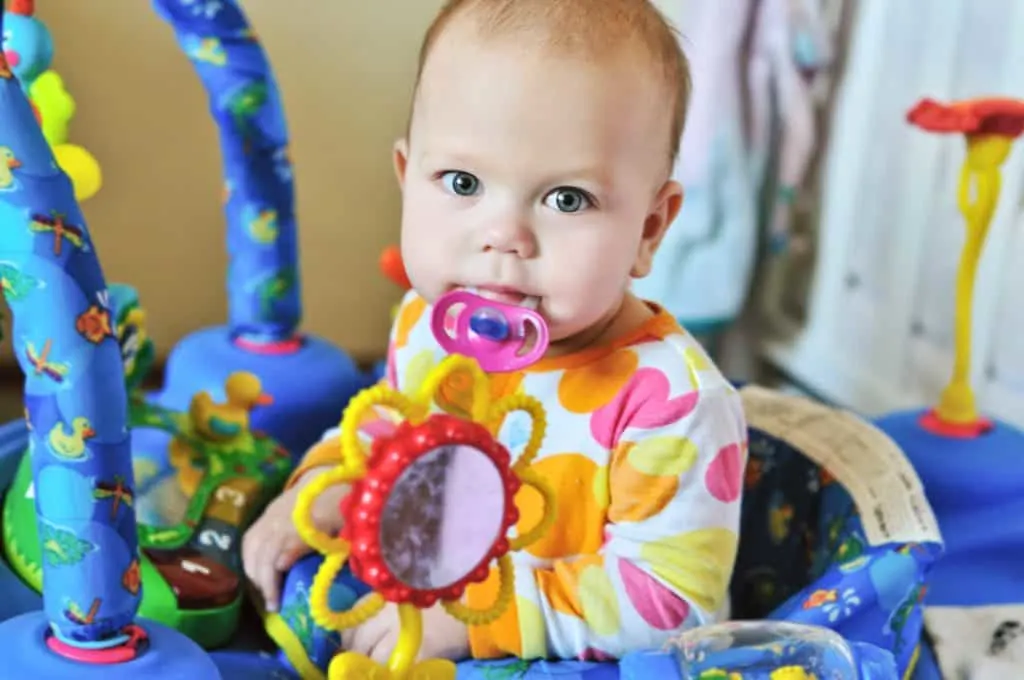
You do not need to buy any special toys to help your baby walk or stand.
You can use yourself or things around the house to help motivate your little one.
Setting favorite toys that they like up on the couch can be a perfect way to encourage them to cruise alongside of it or just play in the standing position.
Baby activity centers that allow your baby to cruise around can be a fun toy for them to explore while in a standing position but are not necessary to help your little one learn to stand.
The best toys to help with baby standing are the ones that motivate your baby to move.
One toy that you will want to avoid are infant walkers.
These do not help your baby walk and can be quite dangerous.
What can I do to help my baby stand?
There are lots of ways to encourage your baby so that they can gain the skills needed to stand.
Teaching your baby to pull up to stand can be done through play and daily routines.
Let’s take a look at how you can help them from the very beginning:
Newborn
- Encourage tummy time from the very beginning. Core strength is very important when it comes to standing and tummy time allows your baby to build core muscles. Start out with short intervals and watch your baby’s cues. If they seem uncomfortable then take a break from it. Always supervise your baby closely when they are lying on their stomachs.
3-6 Months
- Giving your baby lots of floor time is still very important. Let them build their motor skills by rolling around and pivoting. Always make sure to baby proof your house thoroughly.
- Explore different positions with your baby. Give them support on the floor in a seated position.
- Infant seats and bumbo chairs (like these) are fine to use in small amounts. You helping your baby sit on the floor is the best way to encourage muscle strength.
6-9 Months
- Help your baby bear weight on its legs for short periods of time. Watch their cues and follow their lead.
- Provide your baby with safe ways to play in a supported standing position. Placing toys (like this one) on the couch while you help support them is a great way to get some practice in.
- Jumparoos, bouncers, and activity tables are fine in small doses. They will not help teach your baby to stand and they can have harmful effects if overused. (Source).
9-12 Months
- Help your baby move from a seated position to a standing position.
- Supervise your baby when they start attempting to stand alone for a few seconds at a time.
- Support your little one by hand-holding as they attempt to walk. You could also use walking wings (like these) to give your back a break!
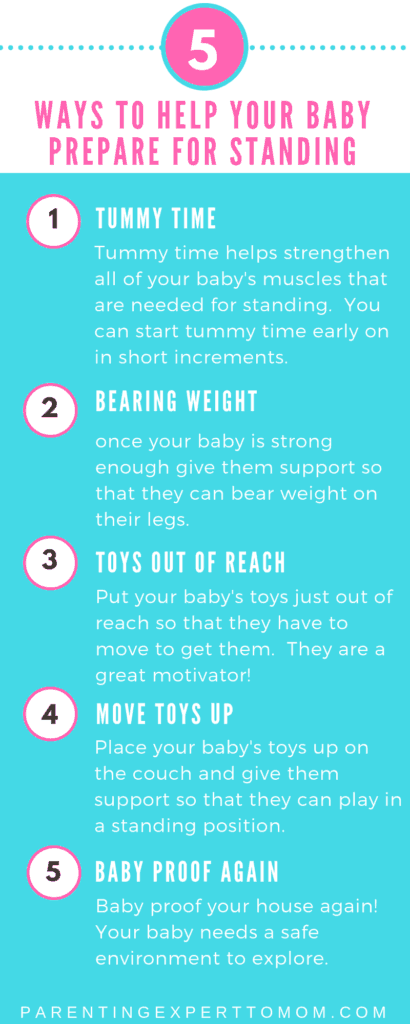
Standing Milestones You Can Expect
Starting to Bear Some Weight on Legs
At about 3-5 months you can expect your baby to start bearing some of their weight on their legs when placed in a standing position.
Bears Most of Their Weight on Legs
At around 5-6 months your baby may start to really show interest in being in a supported standing position.
By this age, they should be able to bear most of their weight on their legs when placed in an assisted standing position.
Pulls to Standing Position Using Furniture
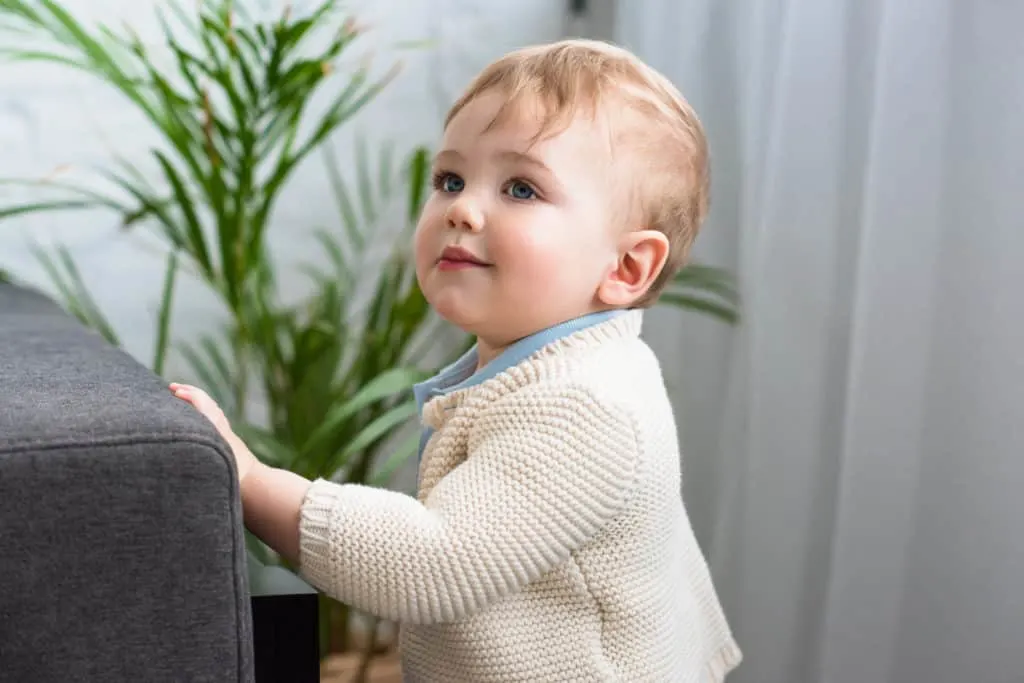
When do babies pull themselves up on furniture to a standing position?
Anywhere from 6-10 months, you can expect your baby to start using furniture to pull up on.
It is a good time to check your crib height to make sure it is low enough so that they can’t fall out if they were to pull up on the railing.
Lowering from Standing to Sitting
Has your baby pulled up to stand next to something…only to find out they don’t know how to get back down?
This is very common as typically they learn to pull up to stand before they figure out how to reverse.
Your little one will learn how to lower themselves back down to a sitting position at around 9-10 months.
When do babies stand?
Standing Briefly Without Support
You turn around to look at the dog barking only to turn back and see your baby standing with no support!
Maybe they took their hand off the couch to start testing the new waters.
Such an exciting time as you know what will be coming next!
You can start watching for your baby to start standing for a couple of seconds here and there at about 9-13 months.
Stands Well With Out Support
The moment you have been waiting for…your baby is standing!
So when do babies start standing?
Somewhere between 11-14 months, your baby will have the strength to stand well on their own with no support.
Looking Through Legs
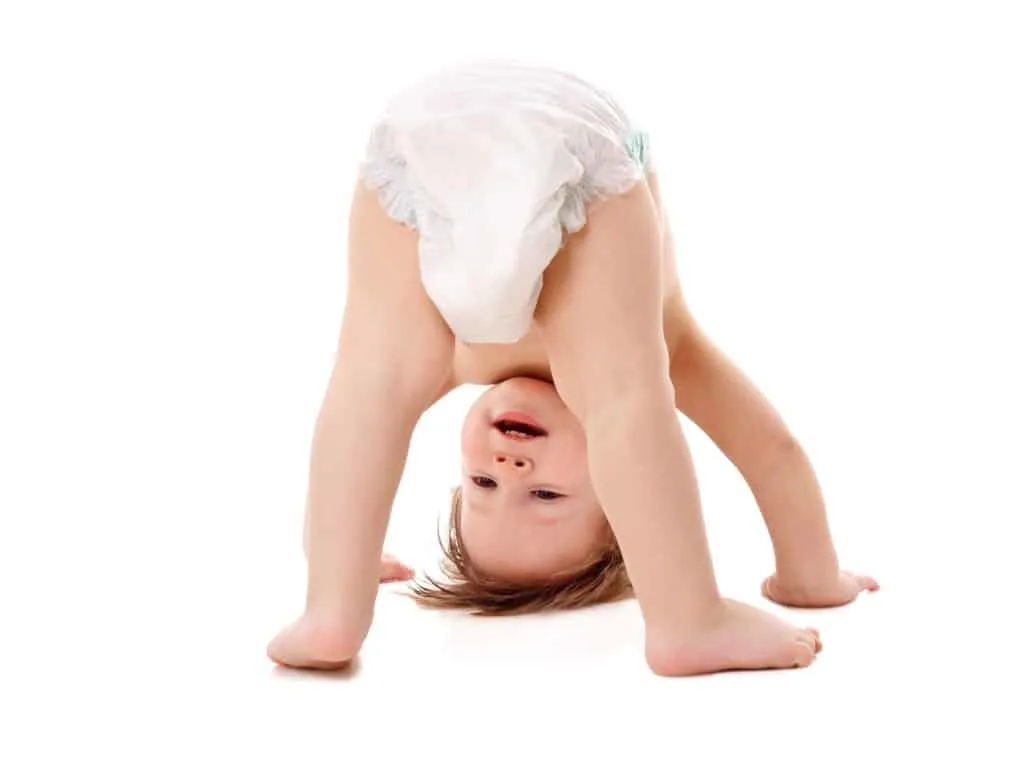
After your baby has been standing for a while they will continue to master their balance and new skills.
Being able to bend and look through their legs is something that happens usually between 14-16 months.
You may see this occur during playtime or while looking for toys or a ball that has been thrown.
Stands On One Foot With Assistance
Now that your little one has mastered standing on two feet they will be up for the next challenge.
Standing on one foot requires lots of balance and coordination.
You can expect them to start trying out this skill around 16-17 months.
Make sure that you give them the support they need when they are trying this out.
You can even have fun with this by modeling it for them.
Squatting During Playtime
Squatting is a very functional skill that happens during play-time or while cleaning up.
When your little one has the strength and coordination they will begin to use squatting often to retrieve toys.
Squatting typically happens around 20 months.
Standing on Tiptoes
Has your child started to get to things that used to be out of reach?
When your toddler is able to stand on their tiptoes you may want to baby- proof yet again as they will be able to get into things they couldn’t before!
You can expect your child to start standing on their tiptoes sometime around 23-27 months.
My baby isn’t standing…should I be concerned?
If you are concerned about your baby not being able to stand or any developmental milestone you should contact your pediatrician or the early intervention program in your area.
Early intervention can meet with you and will provide you with a free screening or evaluation to address your concerns and make sure you little one is on track.
You can read more about early intervention services here.
Always listen to your gut.
If you feel like something is not right, go seek help.

What red flags should I watch out for?
Babies will develop on their own timeline and there is a range of normal when it comes to development.
However, here are some things that you can pay attention to as your baby develops:
Muscle Tone
Is your baby very stiff and rigid?
Is your baby “floppy” and has trouble supporting themselves?
These are both reasons to give your pediatrician a call.
Uneven Strength
Is your baby weaker on one side than the other? Do they only reach with one hand?
Skill Regression
Does your baby have a skill but then lose it? Schedule a visit with your pediatrician if this occurs.
My Baby is standing! What milestones should I expect next?
What an exciting milestone for your baby to hit!
Now that your baby is standing I am sure that you can guess what comes next.
If you guessed walking…you are correct!
Babies typically start walking with both hands held between 10-12 months.
Walking independently usually happens anytime between 13-15 months.
As your baby…or should I say toddler gains strength and coordination their walking will become more steady and fewer falls will occur.
My baby stopped talking while learning to stand and walk…should I be concerned?
This was something I saw happen a lot while I worked in early intervention.
Sometimes babies may become so focused on their motor milestones that they may talk less or become more quiet.
However, if you have concerns with your baby’s language development or you feel that their skills are regressing ALWAYS talk to your pediatrician or give early intervention a call.
What shoes work best for babies to learn to stand and walk in?
Having your baby barefoot is the BEST option to help your baby learn to stand or walk.
Are you surprised by that?
Here is why barefoot is best:
Babies need to be able to feel the earth beneath their feet in order to learn balance and control.
They use their toes to help balance as well and having shoes and socks on can make this difficult to do.
If you must put shoes on your baby try a pair with a flexible sole when they are learning to walk. These are the ones we used with my son and they worked perfectly (and they are super cute!)
What activities encourage baby standing?
Your baby can practice standing while you go about your daily routines.
For example, if you are having some floor time, set the toys up on the couch and have your baby play in a standing position while you give them support.
Get creative! Always watch your baby’s cues and if they seem tired…make sure to give them a break!

Explore New Surfaces
Explore different surfaces with your baby when they are learning to stand or walk.
Bring them to different rooms in your house and let them explore barefoot.
Put them on floors that have carpet, tile, or any other type, and let them explore barefoot.
Bring them outside and do the same.
Let your child try to walk on the grass and see how they react.
If they seem uncomfortable or scared you may need to introduce it more slowly.
Will an exersaucer help my baby learn to stand and walk?
Exersaucers do not teach your baby to learn to stand or walk.
You are the “best toy” your baby can use to help with standing.
They are fine to use for short periods of time (about 15 minutes) but it is not a good idea for them to spend long amounts of time in them. (Source)
What will NOT help your baby learn to stand
Do not rely on baby walkers or bouncers to teach your baby to stand and walk.
Baby walkers have been deemed unsafe by the APA (read more about that here.)
Bouncers, exersaucers, and jumpers can be ok to use for short amounts of time only.
You will also want to look closely at the manufacturer guidelines as to how your baby’s feet should be positioned in one of these toys.

Grab your FREE Milestone Guide HERE.
Will standing too early cause my baby to be bowlegged?
Are you concerned about your baby standing too early?
You do not need to worry about your baby becoming bowlegged from standing early.
All children follow different timelines.
You can read more about this debunked myth HERE.
Safety Concerns When Your Baby is Learning to Stand
The biggest safety concern when your baby is learning to stand is the risk of falling over.
It is important to give your baby the proper support they need to avoid falls and injuries.
Watch your baby’s cues as well.
Do they seem tired?
Standing is a lot of work so they may only want to bear weight on their legs for short bits of time to start with.
As they get older and build more muscle they may be able to tolerate a longer amount of time in the standing position.
Baby Proof Your House for New Milestones
You will want to baby proof your house again to accommodate new dangers that present as your little one becomes more mobile.
Your baby will have a whole new world to explore as they become mobile and you want to make sure that they have a safe environment to explore in.
Here are a few things you will want to check on:
- Lower the crib height. As your baby builds their arm strength you will want to lower your crib so that they can not climb out or fall out.
- Protect sharp corners on fireplaces or coffee tables. You can grab some corner covers to avoid head injuries from sharp corners (this is what we used).
- Make sure any cord or curtain string is up high enough so that your baby can not reach them.
- If you haven’t already make sure to have stairway gates in place to keep them off of the stairs.
- Always make sure there are no choking hazards within reach.
- Lock all cabinets that may not be safe for your child.
- Cover all electrical outlets.
I think that covers just about everything! Have a parenting question? Make sure to follow on Instagram!
Related Posts You Will Enjoy
How to Encourage Toddler Development at the Park
Best toys for babies 0-12 Months
How to Choose the Best Activity Table for Your Baby
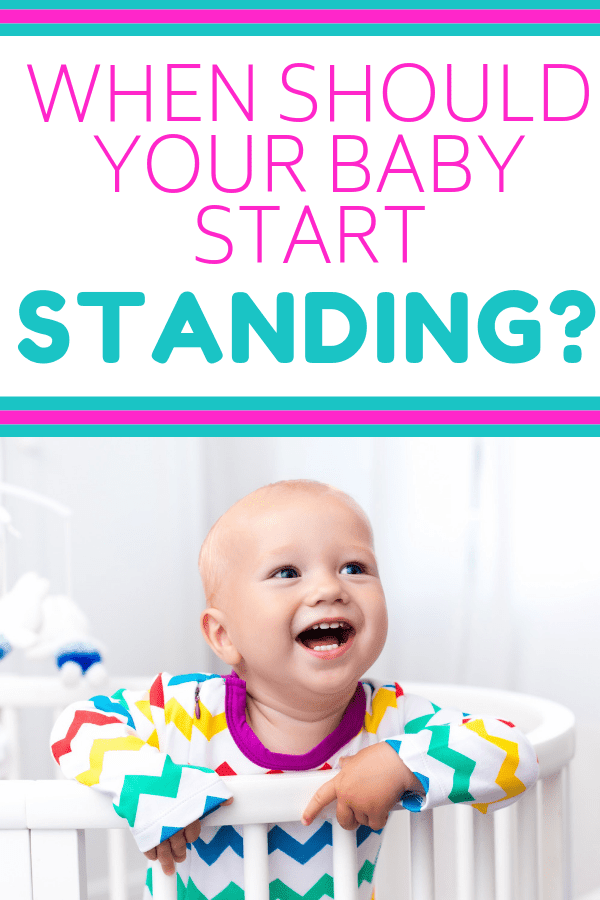

Kayla O’Neill has a master’s degree in education as well as a bachelor’s degree in special education with an emphasis in early childhood education. She has been working as a developmental therapist with babies and toddlers in early intervention since 2012. She is also a mom with two young children.
